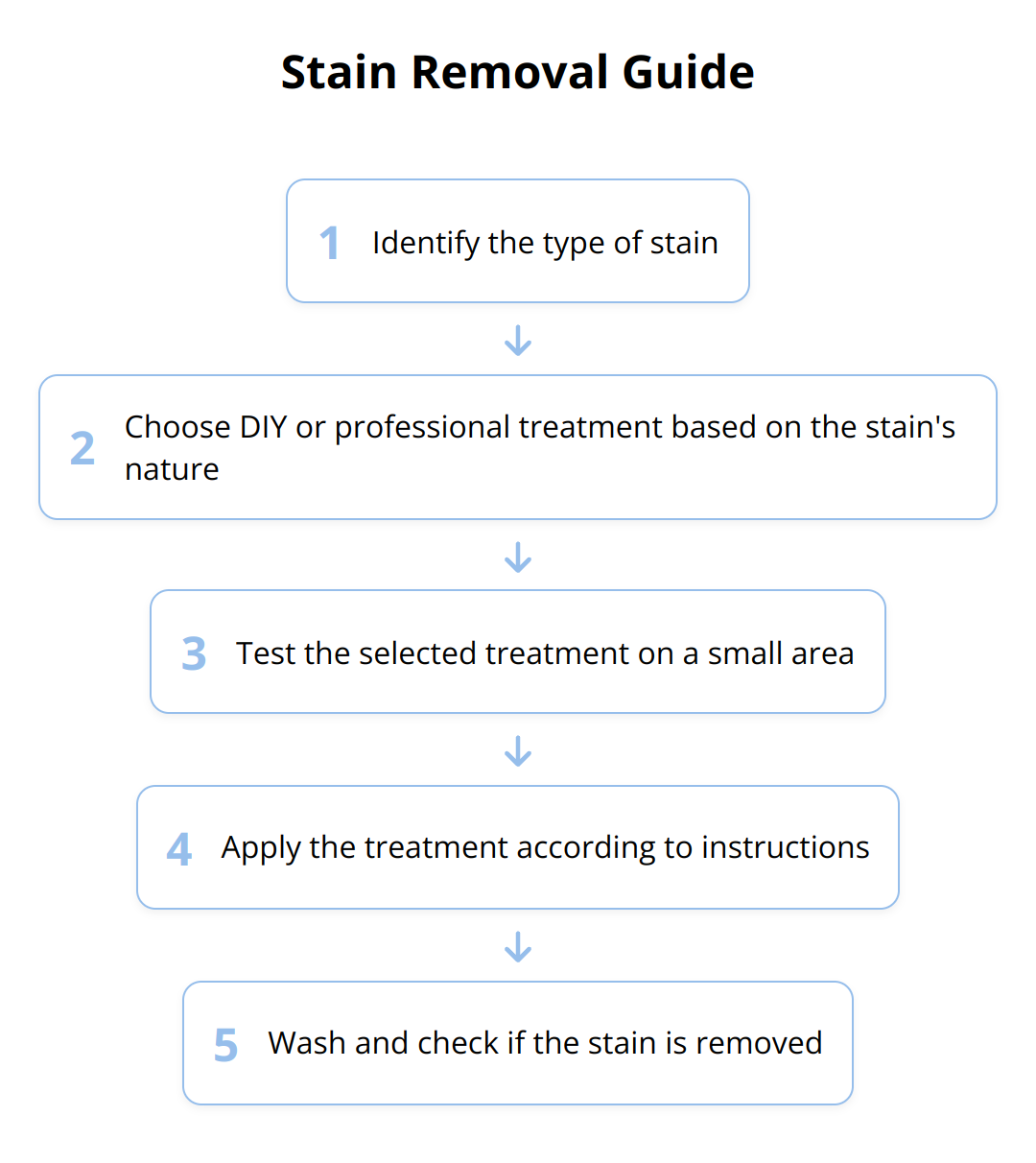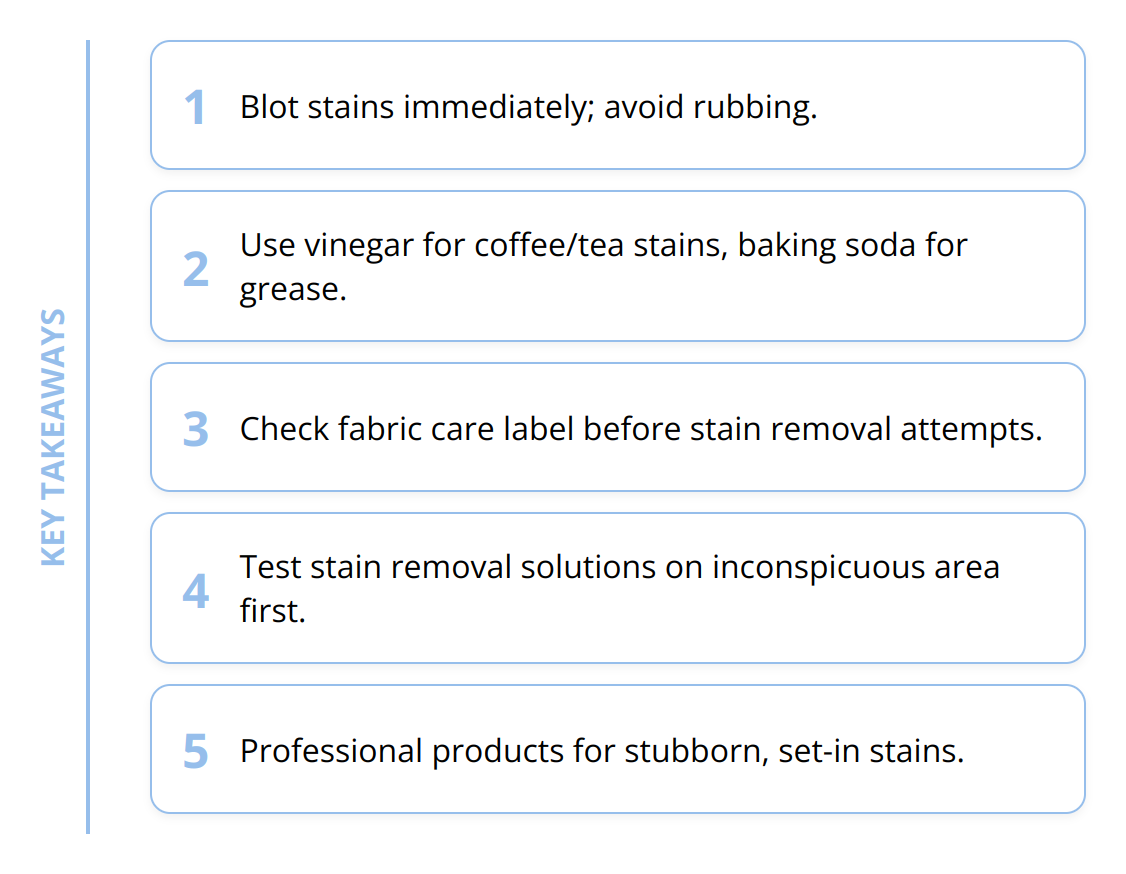Stains are an inevitable part of life, but they don’t have to be a permanent mark on your belongings. Knowing how to tackle them quickly and effectively can save you time and preserve your favorite items.
At The A Team Cleaning Services, we believe in empowering you with the knowledge to address any kind of stain, from the everyday mishaps to the more stubborn ones. Let’s explore the best strategies for quick stain removal.
Tackling Different Stain Types
When it comes to stain removal, not all stains are created equal. Understanding the type of stain you’re dealing with is the first step to choosing the right strategy for removal. Let’s break down the broad categories and offer specific tips on handling common household stains.
Organic Stains
Organic stains come from natural substances like food, drinks, and bodily fluids. These are among the most common stains you might encounter on a daily basis. Coffee, tea, wine, and chocolate fall into this category, along with blood and sweat. Immediate action is key with organic stains. Rinse or soak the stained area with cold water as soon as possible. Avoid hot water, as it can set the stain deeper into the fabric. For tough organic stains, applying a mixture of hydrogen peroxide and dish soap before washing can work wonders.
Inorganic Stains
Inorganic stains originate from non-living materials, such as ink, dye, and mud. These stains often require a different approach due to their chemical composition. For instance, ink stains can be effectively treated with rubbing alcohol or nail polish remover before laundering. Mud stains should first be allowed to dry completely; then brush off the excess before washing. Patience and the right solvent are your best friends here.
Oil-Based Stains
Oil-based stains are trickier due to their greasy nature. They can come from cooking oil, butter, makeup, and even certain lotions. The key to tackling oil-based stains is to use a product that can break down the oil, such as liquid dish soap or a pre-treatment stain remover designed for greasy stains. Apply the solution directly to the stain, gently rub it in, and let it sit for a few minutes before washing as usual.

Quick Stain Removal Tips:
- Act fast: The sooner you address the stain, the better your chances of removing it.
- Identify: Knowing whether a stain is organic, inorganic, or oil-based helps you choose the right treatment.
- Test first: Always conduct a spot test on a hidden area of the fabric to ensure the treatment won’t cause damage.
- Rinse before washing: Pre-rinsing stains with cold water can help prevent them from setting in fabric.
- Check before drying: Make sure the stain is completely gone before putting the item in the dryer, as heat can set stains permanently.
For more specific advice, like how to clean natural stone surfaces or the best techniques for revitalizing your home with spring cleaning, refer to our detailed guides. With the right approach, you can effectively tackle any stain, preserving the life and appearance of your favorite items.
Immediate Stain Combat Tactics
Tackling stains the moment they happen can significantly increase your chances of removing them completely. However, it’s essential to approach this task with the right technique and knowledge to avoid setting the stain deeper into the fabric.
Blotting vs. Rubbing: The Right Way to Address a Fresh Stain
The first rule of immediate stain removal is to blot, not rub. Rubbing a stain can push it deeper into the fibers, making it harder to remove and potentially damaging the fabric. Instead, use a clean, dry cloth or paper towel to gently blot the stained area. Apply pressure to absorb as much of the spill as possible without spreading it further.
For liquid stains, working from the outside in prevents enlarging the stain’s boundaries. For more solid or semi-solid substances like sauces or makeup, carefully lift any excess off the fabric with a dull knife or spoon before blotting.

The Importance of Reading Fabric Care Labels
Before applying any stain treatment, it’s vital to check the fabric care label. These labels provide crucial information on how to safely clean the garment without damaging it. Some fabrics are sensitive to water, while others can be damaged by specific cleaning agents.
For instance, silk and wool require different care than cotton or synthetic materials. Using hot water or the wrong type of cleaner on these sensitive fabrics can result in irreversible damage. Similarly, some garments may be dry clean only, indicating that home stain removal attempts could do more harm than good.
Key Takeaways:
- Blot stains immediately with a clean cloth; never rub.
- Use a dull knife or spoon to remove excess substance before blotting.
- Check the fabric care label before attempting stain removal.
- Test any stain removal method on an inconspicuous area first.

Implementing these immediate actions can prevent stains from setting and help maintain your clothing’s appearance and longevity. Just remember, the faster and more appropriately you act, the better your results will be.
For guidance on handling specific types of stains, like those tricky ink stains or stubborn wine spills, our resources, including guides on biodegradable cleaning products and eco-friendly cleaning gadgets, offer practical, effective solutions.
DIY vs Professional Stain Removal
Navigating the maze of stain removal can be daunting. The choice between DIY solutions and professional products isn’t always clear. However, understanding when and how to use each approach can make a substantial difference.
DIY Solutions: Harnessing Household Items
The power of household items like vinegar and baking soda in fighting stains is undeniable. For a simple yet effective treatment, vinegar works wonders on coffee and tea stains. Dabbing vinegar directly onto the stain before washing can lift it right off. Similarly, baking soda is a hero for grease stains. Creating a paste of baking soda and water and applying it to the stain can absorb the grease, making it easier to wash out.
- Wine stains: Cover the area with baking soda, let it absorb the liquid, then wash.
- Ink: Apply rubbing alcohol to the area before rinsing.
These methods are safe for most fabrics and incredibly budget-friendly. Yet, the key is acting swiftly. The longer a stain sits, the tougher it will be to remove with home remedies.
Professional Products: When to Upgrade
There are times when DIY just won’t cut it. This is particularly true for set-in stains or those from tricky substances like blood or red wine. Professional-grade stain removers are formulated to tackle these stubborn stains without damaging the fabric. Products like enzyme-based cleaners can break down organic material, making them perfect for bodily fluids or food-based stains.
- Oil-based stains: Opt for a specialized grease-fighting cleaner.
- Dye stains: Seek out a color-safe bleach alternative.
The decision to reach for a professional product often comes down to the fabric’s value and the stain’s stubbornness. For cherished items or where DIY methods have failed, it’s a wise investment.
Remember, always test any product—DIY or professional—on a small, inconspicuous area first. This ensures that the treatment won’t further damage the item.
Key Points
- Act fast: The sooner, the better for both methods.
- DIY works well for fresh, common stains.
- Professional products are best for stubborn, set-in stains.
- Consider the fabric type and stain source when choosing your approach.

Navigating the world of stains doesn’t have to be a nightmare. With the right tools and knowledge, you can keep your belongings looking their best, whether that means reaching into your pantry or your cleaning supply stash. For more specialized advice, our guides on cleaning biodegradable products provide further insights into choosing the best options for your home.
Final Thoughts
In wrapping up, the essence of effective stain removal hinges on quick action and knowledge of the stain type. Whether it’s an accidental coffee spill, a grease mark from cooking, or an ink stain, understanding the nature of the stain is paramount. Here’s a brief recap:

- Act fast: The longer a stain sits, the harder it becomes to remove.
- Blot, don’t rub: This prevents the stain from setting deeper into the fabric.
- Choose the right solution: Whether a DIY method or a professional product, picking the appropriate treatment makes all the difference.
- Fabric care is key: Always check care labels before attempting stain removal.
- Test first: Ensure the cleaning method won’t damage your item by testing on a small area.
While these tips can save many of your items from permanent damage, sometimes, stains prove too stubborn, or the risk of damaging delicate fabrics is too great. In such cases, turning to professionals like us at The A Team Cleaning Services ensures your items receive the best care. We use professional-grade products tailored to each cleaning task, preserving the integrity of your items and leaving your space immaculately clean. Whether it’s a treasured garment or your entire home needing attention, our experienced team is here to provide a thorough clean, allowing you to enjoy a fresher, cleaner environment without the hassle. Remember, the state of your spaces impacts your comfort, health, and overall well-being, making professional cleaning an investment in your quality of life.
In the end, the key takeaway is to tackle stains head-on with the right approach for the best results. And when in need, professional help is just a call or click away, ready to restore your peace of mind with pristine clean spaces.
